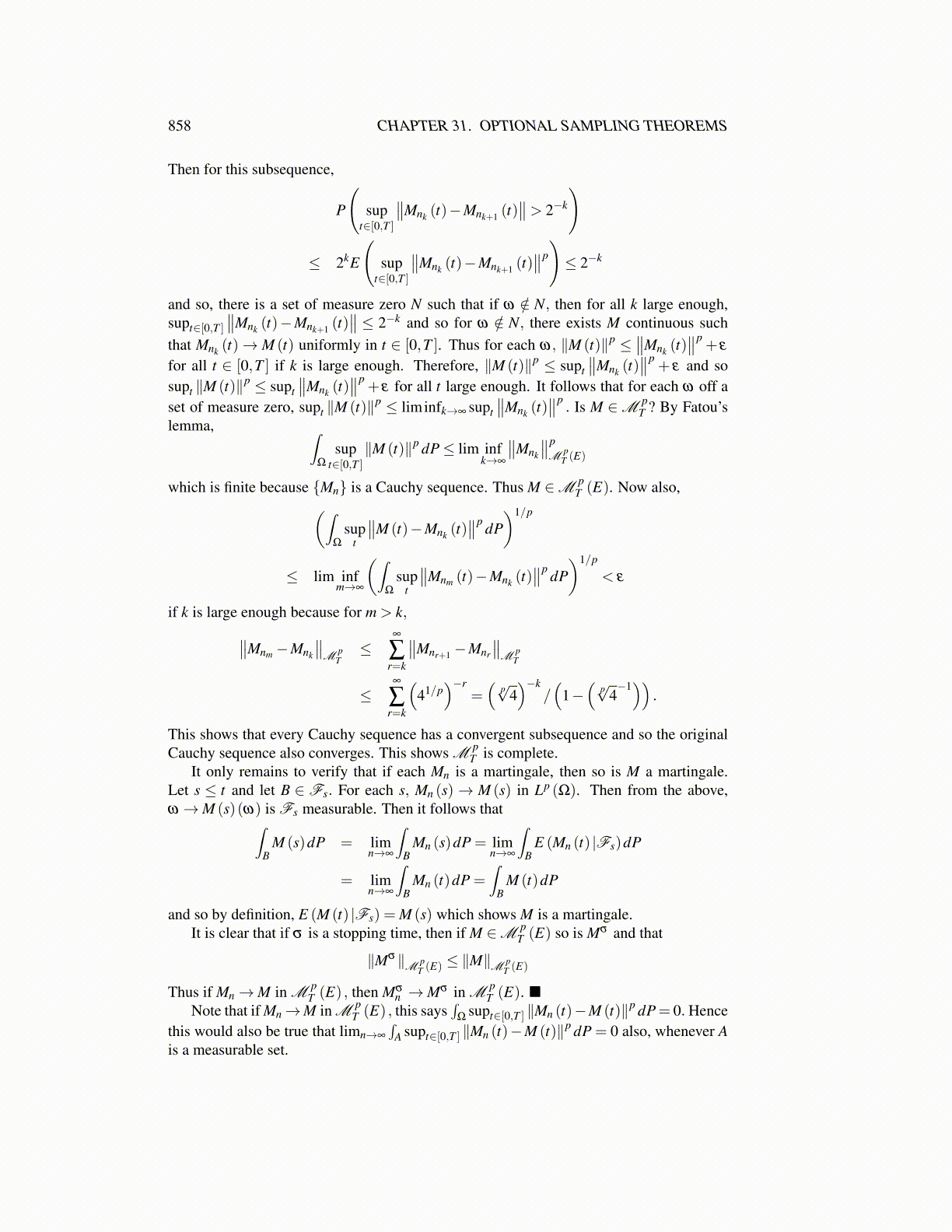
858 CHAPTER 31. OPTIONAL SAMPLING THEOREMS
Then for this subsequence,
P
(sup
t∈[0,T ]
∥∥Mnk (t)−Mnk+1 (t)∥∥> 2−k
)
≤ 2kE
(sup
t∈[0,T ]
∥∥Mnk (t)−Mnk+1 (t)∥∥p
)≤ 2−k
and so, there is a set of measure zero N such that if ω /∈ N, then for all k large enough,supt∈[0,T ]
∥∥Mnk (t)−Mnk+1 (t)∥∥ ≤ 2−k and so for ω /∈ N, there exists M continuous such
that Mnk (t)→M (t) uniformly in t ∈ [0,T ]. Thus for each ω, ∥M (t)∥p ≤∥∥Mnk (t)
∥∥p+ ε
for all t ∈ [0,T ] if k is large enough. Therefore, ∥M (t)∥p ≤ supt∥∥Mnk (t)
∥∥p+ ε and so
supt ∥M (t)∥p ≤ supt∥∥Mnk (t)
∥∥p+ ε for all t large enough. It follows that for each ω off a
set of measure zero, supt ∥M (t)∥p ≤ liminfk→∞ supt∥∥Mnk (t)
∥∥p. Is M ∈M p
T ? By Fatou’slemma, ∫
Ω
supt∈[0,T ]
∥M (t)∥p dP≤ lim infk→∞
∥∥Mnk
∥∥pM p
T (E)
which is finite because {Mn} is a Cauchy sequence. Thus M ∈M pT (E). Now also,(∫
Ω
supt
∥∥M (t)−Mnk (t)∥∥p dP
)1/p
≤ lim infm→∞
(∫Ω
supt
∥∥Mnm (t)−Mnk (t)∥∥p dP
)1/p
< ε
if k is large enough because for m > k,∥∥Mnm −Mnk
∥∥M p
T≤
∞
∑r=k
∥∥Mnr+1 −Mnr
∥∥M p
T
≤∞
∑r=k
(41/p
)−r=(
p√4)−k
/(
1−(
p√4−1))
.
This shows that every Cauchy sequence has a convergent subsequence and so the originalCauchy sequence also converges. This shows M p
T is complete.It only remains to verify that if each Mn is a martingale, then so is M a martingale.
Let s ≤ t and let B ∈ Fs. For each s, Mn (s)→ M (s) in Lp (Ω). Then from the above,ω →M (s)(ω) is Fs measurable. Then it follows that∫
BM (s)dP = lim
n→∞
∫B
Mn (s)dP = limn→∞
∫B
E (Mn (t) |Fs)dP
= limn→∞
∫B
Mn (t)dP =∫
BM (t)dP
and so by definition, E (M (t) |Fs) = M (s) which shows M is a martingale.It is clear that if σ is a stopping time, then if M ∈M p
T (E) so is Mσ and that
∥Mσ∥M pT (E) ≤ ∥M∥M p
T (E)
Thus if Mn→M in M pT (E) , then Mσ
n →Mσ in M pT (E). ■
Note that if Mn→M in M pT (E) , this says
∫Ω
supt∈[0,T ] ∥Mn (t)−M (t)∥p dP= 0. Hencethis would also be true that limn→∞
∫A supt∈[0,T ] ∥Mn (t)−M (t)∥p dP = 0 also, whenever A
is a measurable set.